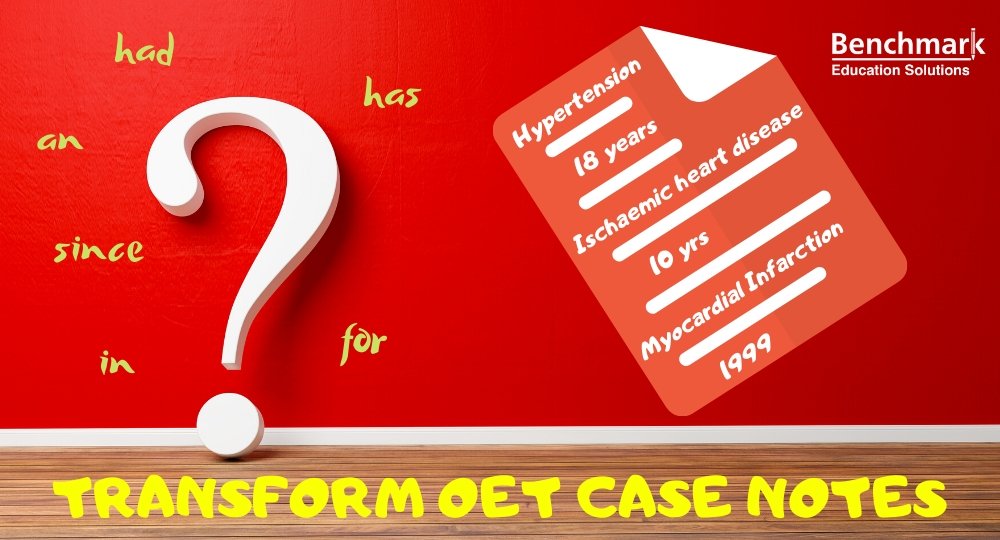
The key skill that you are being tested on in the OET writing sub-test is transforming case notes into a letter from one medical professional to another. This most often takes the form of a referral letter. As well as extracting the information from the case notes that is most relevant to the brief and discarding information that is not, it is crucial that you get used to turning the notes into well-developed sentences.
Table of Contents
There are particular skills which you will need to use to create full sentences from notes in general. In addition, you will need to bear in mind the appropriate style of writing for a medical letter, formal and to the point, with necessary detail while still succinct. You will also be using the type of phrasing and vocabulary associated with medical letters that you will be getting accustomed to through your use of sample materials.
Why are the little words so important?
What we sometimes see is case notes copied, or if not reworded, but not in full sentences. Your letter is a formal piece of writing, and although it is not an essay, it must have the same fluency to some extent. If you are listing medications or symptoms, for example, you must begin and end the sentence correctly and use the appropriate linking words and qualifying words. It is the little words that make the big difference here. Not only do they show that your grammar is adequate and that you understand how to use grammatical constructs correctly, they replicate an actual medical letter.
“Little” word categories
So which little words are we talking about and which words are often missed out when transforming case notes into finished sentences?
Articles
Firstly, and these are the types of word that are missed out the most by far, are articles. So many English words take an article where many other languages don’t, so this is an easy mistake for students who speak those languages to make. Also, some words don’t take an article, and you need to choose the correct type of article – a, an or the! As you can see, it is important that you spend time revising article use, especially in terms of medical terminology relevant to OET such as symptoms, roles and medications, but also in general to form sentences correctly.
Pronouns
Pronouns are another word category that are often missed out, especially possessive pronouns such as her/his which could be used in the same way as an article before a noun, but also remembering to use she, it, himself, whose, these etc. Pronouns are words which replace a noun or a noun phrase. There are many types of pronouns and revision of the different pronouns and how to use them will be helpful when it comes to turning notes into sentences.
Conjunctions
Next, we move onto joining words that really link the words of a sentence together. The most obvious of these are conjunctions. On many occasions, conjunctions are the best way to connect a sentence and the use of conjunctions instead of commas can turn a list into a sentence. You will also need to use commas and conjunctions in some of your sentences and it is necessary to learn when each is appropriate. Some examples of conjunctions are: and, but because, yet and so.
Prepositions
Prepositions are also often forgotten (or the wrong prepositions used). Prepositions are words that show you the relationship between the two words either side of them. They often give you more information about the “where or when” although they can have other functions too. Some examples of prepositions are: on, from, before, during, above, for, in and until.
Auxiliary Verbs
Finally, auxiliary verbs are commonly omitted and are often necessary to create a complete sentence. Auxiliary verbs are also known as helping verbs which is quite apt as they will help you to write proper sentences. Don’t be put off by the complicated sounding title. To keep it simple, we will think about the most common auxiliary words…to do, to have, to be. E.g. She is having – ‘to have’ (having) is the main verb, ‘to be’ (is) is the helping verb. We have operated on him. ‘To operate’ (operated) is the main verb, ‘to have’ (have) is the helping verb. We often see examples of candidates missing out the auxiliary verb, using the main verb only and this does not work grammatically in a full sentence even if it would work in note-form.
Example
Here is an example of some information turned into complete sentences using case notes from the materials that we provide for OET writing practice and correction. The articles, pronouns, conjunctions, prepositions and auxiliary verbs have been highlighted.
Past history
Hypertension 18 years
Ischaemic heart disease 10 yrs
Acute Myocardial Infarction 1999
Mr Brown has had hypertension for 18 years, ischaemic heart disease for 10 years and he had an acute myocardial infarction in 1999.
As you can see from this example, all of the types of “little” words that we have discussed are used in this sentence. Have a go at identifying each type of word highlighted to check that this is true.
Abbreviations and Capitalisation
What else do you notice has been changed from the notes in order to create a sentence? That’s right, yrs has been changed to years. Abbreviations are generally best avoided in a referral letter unless they are in brackets following the full version, especially in regard to conditions. Finally, the conditions are not written in capitals as this is the guidance given. You can refer to our extensive revision materials to look into these areas further.
Evidently, there is a big difference between case notes and a formal letter. That big difference is made by using little words. The types of words mentioned are also a great place to focus your grammar revision in general so you will be doubling up your learning power! Now that you have read this article, why not choose a paragraph, write or type it out and highlight all of the propositions, conjunctions etc. Then make lists of all the words of each type that you found in that paragraph. You will soon see that all sentence construction relies heavily on these word types. The next step is to have a go yourself. Try turning some simple case notes into a sentence or two as we have seen above. Finally, try out our practice materials and OET Writing Correction Service to become an expert at turning case notes into excellent medical letters.





Thank you very much for your help
Thanking you for your valuable information. I have problem in writing and , always my writing score is below 300. Please, give some suggestions..
OET Writing Correction
Thank you so much for the above information.
I also need to improve my writing skill
Read the following first:
OET Sample Referral Letter
OET Sample Discharge Letter for Writing Test
Also, to improve your writing skills further, you may use our Writing Correction Service: OET Writing Correction
Thank you so much.lnfact your lecture is very impressive and educative.lam very grateful
your explanation was very attractive and intresting ,ineed refferal and discharge letter samples can u send me plz
OET Writing Correction
May I know what are the common informal words used by the candidates?
Thank you!